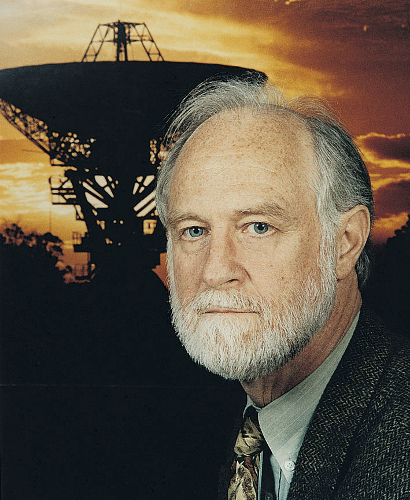 Ron Ekers (CSIRO photo)
Ron Ekers (CSIRO photo)
Ron Ekers
Contributed by Kenneth I. Kellermann
The 2014 Grote Reber Gold Medal for innovative and significant contributions to radio astronomy will be awarded to former NRAO VLA Director, Ron Ekers who is currently a CSIRO Fellow at the Australia National Telescope Facility, CSIRO Division of Astronomy and Space Science in Australia, Adjunct Professor at Curtin University in Perth and at the Raman Research Institute in Bangalore, India.
Ekers is being recognized for his many pioneering scientific investigations which extend over half a century of research. Working with various colleagues Ron made the definitive determination of the radio galaxy luminosity function, the precise measurement of the deflection of radio waves by the sun, some of the first high resolution images of the radio emission from the center of the Galaxy, made the first high time resolution observations of pulsars leading to the first determination of the Galactic magnetic field, studied the acceleration of the solar wind, gamma-ray bursts, and investigated the distribution of HI in galaxies. More recently he has led a project to detect radio emission resulting from neutrino interactions with the Moon.
On the technical side Ron was instrumental in developing GYPSY, probably the first interactive language for analyzing radio astronomy images, in developing a technique to compensate for missing short spacings in radio arrays leading to the current practice called mosaicing, led the drive to develop phased array feeds, and starting in the mid-1990s he became the strongest force in developing and advocating support for the international Square Kilometre Array initiative.
Ron Ekers graduated from the University of Adelaide in 1963 and received his PhD from the Australian National University in 1967 for research done under John Bolton at Parkes. In addition to NRAO, Ron has worked at Caltech, the Institute of Theoretical Astronomy in Cambridge, and at the University of Groningen, in the Netherlands. In 1988 he returned to Australia to become the Director of the Australia Telescope National Facility, and in 2003 he became an Australian Federation Fellow. He is a Fellow of the Australian Academy of Sciences and the Royal Society of London, a Foreign Member of the Royal Dutch Academy of Science and the American Philosophical Society, and from 2003 to 2006, he served as President of the International Astronomical Union. Over the course of his outstanding career he has served on numerous advisory boards and committees and has received many awards and prizes including the NRAO Jansky Lectureship in 2004.
The 2014 Grote Reber Medal will be presented to Professor Ekers during the 31st URSI General Assembly to be held in Beijing, China in August, 2014.
![[IAU logo]](iau_wb_thumb.jpg)
![[URSI logo]](URSI-logo-thumb.jpg)
![[Karl Jansky at his antenna]](jansky_photo_02_thumb.jpg)
![[Reber's Wheaton antenna]](Reber_Telescope_Wheaton_thumb.jpg)
![[Dover Heights]](Dover_Heights_02_thumb.jpg)
![[4C telescope]](GB61-195_4C_telescope_thumb.jpg)
![[Ewen and horn antenna]](ewen_horn1s.jpg)
![[Dwingeloo, 1956]](Dwingeloo-1956-thumb.jpg)
![[Jocelyn Bell Burnell and Cambridge antenna used in pulsar discovery]](burnell2_thumb.jpg)
![[Lovell Telescope at Jodrell Bank]](site_1594_0001-500-334-20180316163019-thumb150.jpg)
![[Wilson, Penzias, and Bell Labs horn antenna]](wilson-penzias-horn_thumb.jpg)
![[6-m Millimeter Radio Telescope in Mitaka, Japan]](6m-thumb.jpg)

